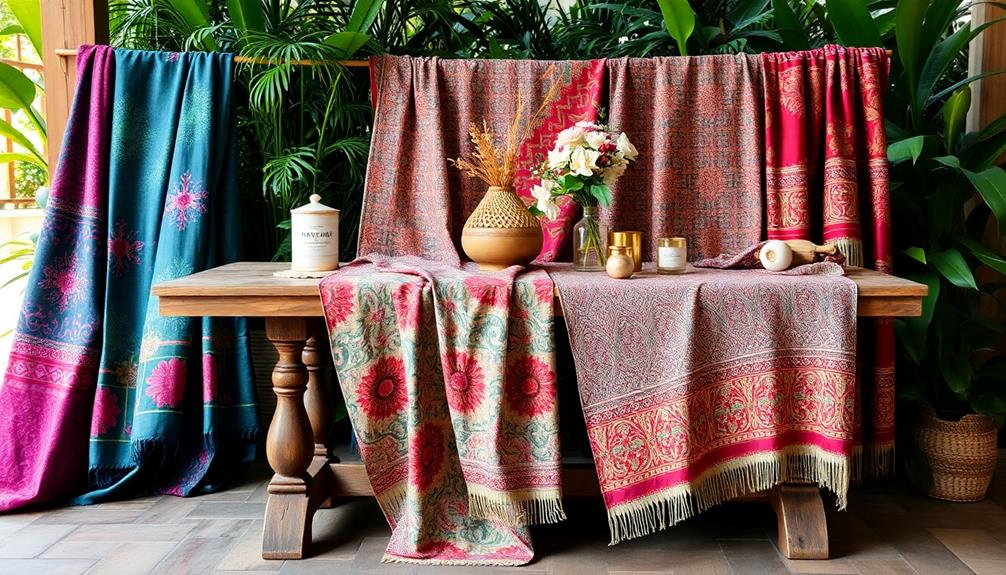Nostalgia plays a role in shaping your food preferences as it brings back fond memories associated with dishes you enjoyed in your childhood. Certain smells, like freshly baked cookies, can evoke feelings of warmth and happiness, transporting you back to simpler times. These emotional connections often drive you to turn to comfort foods when faced with difficult situations, strengthening the ties with your family and cultural background. You may find yourself yearning for traditional meals that provide a sense of belonging and remind you of your identity. Moreover, personal experiences such as traveling can introduce you to new flavors and ingredients, blending nostalgia with fresh culinary experiences. By delving deeper into this connection, you will gain a better understanding of how these memories impact your everyday culinary preferences.
Key Takeaways
- Nostalgic foods evoke comforting memories, influencing preferences and cravings for familiar flavors from childhood and family gatherings.
- Emotional connections to traditional dishes reinforce cultural heritage and create lasting attachments to specific foods.
- Personal experiences, such as travel, introduce diverse flavors that shape food preferences and inspire cravings for unique culinary experiences.
- Cooking and sharing nostalgic meals foster emotional healing and promote a sense of community and belonging through shared experiences.
- Nostalgia can encourage healthier food choices by sparking appreciation for wholesome, familiar dishes that evoke positive memories.
Childhood Food Memories

Childhood food memories linger like the warm scent of freshly baked cookies wafting through the air. These memories often shape your childhood food preferences, creating a lasting impact on your adult cravings. You might find that certain dishes evoke feelings of solace, acting as comfort foods that connect you to simpler times.
For instance, a dish like squash casserole might remind you of family gatherings, where the golden, bubbly layers brought everyone together. The nostalgia tied to these meals can trigger powerful emotional associations, making a single bite or whiff transport you back to cherished moments.
Your cultural background also plays a significant role in these food memories. The flavors and cooking techniques passed down through generations resonate deeply, forming a unique bond with the dishes that defined your upbringing. Whether it's your grandmother's special recipe or that favorite snack after school, these influences shape your relationship with food.
A striking 76% of consumers aged 22-55 enjoy foods that remind them of their past, underscoring how nostalgia shapes food preferences.
Emotional Connections to Food

Food holds the power to evoke deep emotional connections, often acting as a bridge to our past. When you smell a familiar dish, it can trigger powerful memories, thanks to the olfactory system's direct link to your brain's emotional center. Nostalgic foods provide comfort during tough times, like enjoying ice cream after a breakup. It's no surprise that over 76% of people aged 22-55 crave foods that remind them of their past, highlighting how nostalgia influences food preferences across generations.
| Nostalgic Foods | Emotional Connections | Family Traditions |
|---|---|---|
| Grandma's cookies | Warmth and love | Sunday dinners |
| Mom's lasagna | Security and comfort | Holiday feasts |
| Dad's BBQ ribs | Joy and celebration | Family reunions |
| Ice cream sundaes | Healing and solace | Childhood memories |
Cooking and sharing these nostalgic meals can alleviate stress and foster joy. Each dish tied to cultural heritage reinforces emotional bonds with family and friends, preserving cherished memories through culinary practices. So, next time you indulge in a favorite meal, remember the deeper connections it holds.
Cultural Heritage and Cuisine

While you may not realize it, your cultural heritage plays an essential role in shaping your food preferences and experiences. The traditional dishes you grew up with often symbolize connections to your family and cultural history. Specific flavors, spices, and cooking techniques unique to your culture create a lifelong attachment to those culinary traditions.
For instance, dishes like chilaquiles or tamales evoke fond memories of family gatherings and celebrations, highlighting the importance of these meals in our lives.
Think about the meals you cherished during childhood—those comfort foods that remind you of family gatherings and celebrations. These dishes are more than just sustenance; they evoke nostalgia and strengthen community bonds through shared culinary experiences.
Cultural events and holidays frequently feature these cherished foods, making them integral to your identity.
You might notice that your preferences often lean toward ethnic foods that reflect your heritage, whether that's Mexican tacos or Indian curry. The global popularity of these dishes highlights the diversity and richness of culinary traditions.
Impact of Personal Experiences

Your personal experiences, like traveling to new places and exploring local cuisines, play a huge role in shaping your food preferences.
For instance, enjoying dishes like Cylindrical Sticky Rice Cake during festive occasions can create lasting memories.
Those memorable meals—especially the ones you enjoyed at vibrant street markets—often create cravings that linger long after the trip.
As you connect certain dishes to cherished memories, you'll find that your taste for food becomes much more than just about flavor; it's a journey through your past. The emotions tied to meals often amplify the sensory experience, making even a simple dish evoke powerful feelings of nostalgia or comfort. This phenomenon can be explained by the neuroscience behind flavor memory, where the brain forms associations between certain tastes and the moments or people they’re linked to. Over time, these connections solidify, allowing a single bite to transport you back to a family gathering or childhood kitchen.
Travel and Taste Exploration
Traveling opens up a world of culinary possibilities, allowing you to explore diverse flavors and techniques that can reshape your palate. Each new destination introduces you to unique food experiences that broaden your preferences and create lasting cravings. The meals you savor become tied to emotional connections, evoking nostalgia for the places and cultures you've encountered.
For instance, trying a dish like Mushroom Masala can remind you of a cozy evening spent in a vibrant Indian restaurant.
- Street food adventures offer authentic local flavors that resonate long after your journey ends.
- Fusion dishes blend familiar tastes with innovative culinary experiences, enhancing your appreciation for both.
- Sharing your food discoveries with friends and family builds stronger connections through shared experiences.
As you travel, you not only expand your palate but also form memories tied to specific meals, enhancing your overall enjoyment of food. These personal experiences serve as a catalyst for reminiscing about past adventures, deepening your relationship with cuisine.
Each bite carries the essence of a location, making it more than just a meal; it's a bridge to the past. Ultimately, the impact of these travel experiences shapes your food preferences, creating a tapestry of flavors that continuously influences your culinary journey.
Memorable Meals and Cravings
Memorable meals often linger in our minds long after the last bite, shaping our cravings and food preferences in profound ways. Personal experiences, like sharing childhood meals or enjoying unique culinary experiences during travels, create lasting impressions. These experiences often lead to nostalgic cravings for specific dishes that evoke strong emotional responses.
Here's a look at how memorable meals can impact your cravings:
| Type of Meal | Emotional Response | Cravings Triggered |
|---|---|---|
| Childhood Favorites | Warmth and safety | Comfort foods |
| Family Gatherings | Connection and love | Traditional dishes |
| Travel Experiences | Adventure and excitement | Exotic flavors |
| Cooking with Loved Ones | Joy and nostalgia | Homemade treats |
| Holiday Feasts | Celebration and happiness | Festive dishes |
As you reconnect with familiar flavors from the past, your cravings for those cherished meals only intensify. Each bite can transport you back in time, reminding you of the comfort and solace those dishes once provided. Embracing these culinary experiences influences your food preferences, turning nostalgia into a powerful force in your diet.
Street Food Experiences Impact
Street food experiences can profoundly reshape your culinary landscape, introducing you to a world of unique flavors and techniques. Each bite can evoke nostalgia, pulling you back to cherished memories of past travels or shared meals with friends and family.
For example, indulging in dishes like Khanom Tan can enhance your appreciation for traditional desserts that remind you of joyful moments. When you indulge in street food, you're diving into communal settings filled with laughter and connection, reinforcing your positive associations with food.
Consider these aspects of street food's impact on your preferences:
- Unique Flavors: Each dish can introduce you to new tastes that broaden your culinary cravings.
- Cultural Connections: Specific street food items often tie back to cultural events, reigniting childhood memories.
- Adventurous Eating: Exploring these vibrant flavors encourages you to step outside your comfort zone.
As you savor these experiences, they'll leave lasting impressions, prompting you to recreate those flavors at home or seek out similar dishes locally.
Ultimately, your street food adventures deepen your appreciation for culinary diversity, shaping not only your food preferences but also your memories, making every meal a nostalgic journey through time.
Food as Emotional Healing

When you find comfort in familiar dishes, you're tapping into a powerful source of emotional healing. Cooking can be a therapeutic escape, allowing you to channel your feelings into something nourishing.
Dishes like Nettle and Potato Soup and Heirloom Bean Stew not only evoke nostalgia but also provide a sense of warmth and comfort. Sharing these meals with loved ones not only strengthens bonds but also creates a sense of community that lifts your spirits.
Comfort in Familiar Dishes
Many people find solace in familiar dishes that evoke warm memories from their childhoods. These comfort foods often serve as emotional healing during tough times, reminding you of moments filled with happiness and security. For instance, traditional Brazilian dishes like Caldeirada can transport you back to family gatherings by the sea. When you indulge in a beloved meal, you're not just satisfying hunger; you're also nurturing your emotional connections.
Consider how these elements of comfort foods shape your experiences:
- They trigger nostalgic feelings that transport you back to happier days.
- They enhance your perceptions of social support, making you feel connected to loved ones.
- They encourage healthier eating behaviors, reinforcing positive coping mechanisms during stress.
Engaging with traditional recipes and flavors creates a sense of identity continuity. It's like holding onto pieces of your family and cultural heritage, which provides comfort and security.
When you share these meals with others, you create a bond that further fosters joy and alleviates feelings of sadness. By embracing familiar dishes, you not only honor the past but also cultivate a sense of well-being that positively influences your food preferences.
In this way, food becomes more than sustenance; it's a pathway to emotional healing.
Cooking as Therapy
Cooking acts as a powerful form of therapy, allowing you to channel your emotions into something tangible and nourishing. When you engage in preparing nostalgic foods, such as Dorayaki (Red Bean Pancake), you tap into comforting memories that can provide emotional solace during tough times.
This connection between food and psychological healing is profound, as the act of cooking often promotes emotional well-being. As you stir, chop, and sauté, you find a sense of joy and accomplishment that reduces feelings of distress. Nostalgic dishes can evoke positive emotional responses, linking them to significant personal experiences that enhance your sense of identity and continuity in life.
The memories tied to these meals engage your olfactory and limbic systems, deepening the emotional connections you have with food. Moreover, cooking doesn't just benefit you; it also fosters social support. Sharing these comforting meals can create bonds with others who appreciate the same flavors and experiences.
Ultimately, cooking as therapy becomes a way to heal emotionally, reminding you of the love and warmth that food can provide, helping you navigate life's challenges with a renewed sense of hope and well-being.
Sharing Meals Together
Sharing meals together creates powerful emotional connections that enhance the healing process. When you gather around the table with loved ones, you're not just sharing food; you're reinforcing social bonds and creating a supportive environment. These communal dining experiences evoke feelings of connectedness that can help you cope with life's challenges. For instance, enjoying traditional dishes like Agnolotti can transport you back to family gatherings, filled with warmth and laughter.
- Cooking and sharing family recipes often tied to nostalgia can alleviate stress.
- Engaging in food-related activities can trigger happy memories, boosting your emotional well-being.
- Celebrating cultural heritage through traditional dishes reinforces your sense of identity.
Comfort food plays a significant role here. Familiar dishes can provide solace during difficult times, reminding you of cherished moments spent with family and friends.
As you share meals, you're not only enjoying the flavors but also the emotional healing that comes from those connections. Each bite can transport you back to joyful gatherings, strengthening your resolve and sense of continuity.
Ultimately, sharing meals together fosters a nurturing atmosphere where emotional connections flourish, helping you navigate life's ups and downs with a sense of belonging and joy.
Nostalgia and Healthy Choices

Nostalgia can spark a deeper appreciation for healthy food choices, often leading you to seek out dishes that evoke cherished memories. When you reminisce about family dinners filled with colorful vegetables, wholesome meals from your childhood, or rustic breads like Horiatiko Psomi that symbolize hospitality, you naturally become more inclined to consume these nutritious options.
Research shows that nostalgia increases the consumption of healthy foods, helping you reduce unhealthy choices during meals.
Moreover, nostalgic feelings can enhance your perception of social support, making you feel more connected to others who share similar memories. This connection can motivate you to make better food choices, especially when you're feeling stressed or experiencing emotional distress.
Nostalgia serves as a coping mechanism, promoting self-control and encouraging healthier eating habits during challenging times.
Additionally, marketers have recognized nostalgia's potential in shaping healthy eating behaviors. By integrating nostalgic elements into their marketing strategies, they can effectively engage consumers and inspire healthier food choices.
Ultimately, tapping into the power of nostalgia not only fosters a love for healthy foods but also reinforces your connection to the past, making healthy eating a more enjoyable and meaningful experience.
The Role of Aromas and Flavors

Aromas and flavors can transport you back in time, triggering vivid memories tied to cherished meals. The olfactory system's connection to the limbic system makes aromas a powerful trigger for nostalgic food memories.
Think about the scents that remind you of family gatherings or your childhood kitchen. These sensory experiences create emotional bonds and influence your food preferences.
- Familiar aromas can evoke warm feelings of comfort.
- Specific flavors can reveal a treasure trove of childhood memories.
- Cooking traditional recipes can revive cherished moments.
Research indicates that 76% of consumers aged 22-55 enjoy foods that remind them of their past. This strong connection shows how familiar flavors enhance emotional well-being, offering comfort and a sense of continuity with your personal history.
When you cook with traditional recipes, you transform your kitchen into a space filled with emotional reminiscence and connection. Each bite not only satisfies your hunger but also nurtures your soul.
The interplay of aromas and flavors doesn't just shape your culinary experiences; it also enriches your life by allowing you to relive precious memories through the food you love.
Shared Meals and Community Bonds

When you gather around a table with friends or family, the simple act of enjoying a meal together can create powerful connections that last a lifetime. Shared meals strengthen community bonds, as they evoke nostalgia and foster emotional connections among participants. Cultural events often showcase traditional dishes, reinforcing shared identities and collective experiences that deepen your sense of belonging.
Consider the following table illustrating the impact of shared meals:
| Food Experience | Emotional Benefit |
|---|---|
| Family Gatherings | Strengthened intergenerational connections |
| Community Potlucks | Enhanced feelings of belonging |
| Holiday Celebrations | Nostalgic memories of traditions |
| Cooking Together | Creation of lasting memories |
| Sharing Recipes | Passing down culinary heritage |
These food experiences allow you to reminisce about the past, enhancing emotional support within your community. Social media amplifies this nostalgia, letting you share and relive memories tied to specific dishes and food traditions. As older generations pass down beloved recipes, these intergenerational connections become even more valuable, ensuring that the bonds created around shared meals continue to thrive.
Revisiting Comfort Foods

Many people find comfort in revisiting foods that stir up fond memories from their childhood. These comfort foods often hold an emotional connection, reminding you of family gatherings and the warmth of shared culinary experiences.
When you prepare dishes like Handvo, the fragrant aroma can transport you back to cherished moments, reinforcing the power of nostalgia in shaping your food preferences.
- Evoke memories linked to family traditions
- Create opportunities for storytelling
- Foster a sense of identity continuity
Engaging with these nostalgic foods doesn't just provide solace; it also deepens your ties to cultural heritage. As you recreate these recipes, you're not just cooking; you're weaving your personal narrative.
The act of sharing these meals can enhance your well-being and strengthen connections with others, allowing you to relive meaningful experiences.
Nostalgia for comfort foods enriches your life, reminding you of who you're and where you come from. Ultimately, these culinary experiences shape your identity and keep memories alive, making every bite a journey through your past.
Frequently Asked Questions
How Does Nostalgia Influence Our Choice of Restaurant Meals?
Nostalgia influences your choice of restaurant meals by drawing you to familiar flavors and comforting dishes. When you reminisce, you're likely to crave the foods that evoke happy memories, making your dining experience more enjoyable.
Can Nostalgia Lead to Unhealthy Eating Habits?
Nostalgia can turn you into a junk food junkie! When memories of childhood treats flood your mind, it's tempting to indulge. Those deliciously unhealthy choices often feel comforting, but they can lead to some serious habits.
What Role Does Nostalgia Play in Food Marketing?
Nostalgia plays an essential role in food marketing by evoking emotional connections. When brands tap into your fond memories, they create a sense of familiarity, making you more likely to choose their products over others.
How Do Age and Nostalgia Affect Food Preferences?
Imagine walking through a forest of memories, where age and nostalgia intertwine like vines. You'll find that as you grow older, familiar flavors often evoke warmth, shaping your cravings for comfort and connection.
Are There Scientific Studies on Nostalgia and Food Choices?
Yes, there are scientific studies exploring nostalgia and food choices. Researchers have found that nostalgic memories can greatly influence what you crave, often leading you to select comfort foods linked to positive past experiences.
Conclusion
In the end, nostalgia isn't just a fleeting feeling; it shapes your food preferences in profound ways. Did you know that 70% of people say their favorite childhood meals make them feel happier? With every bite of a familiar dish, you're not just tasting flavors but reliving cherished memories and emotions. So, whether it's your grandma's secret recipe or a comforting bowl of mac and cheese, embrace those moments—they're a delicious connection to who you are.









